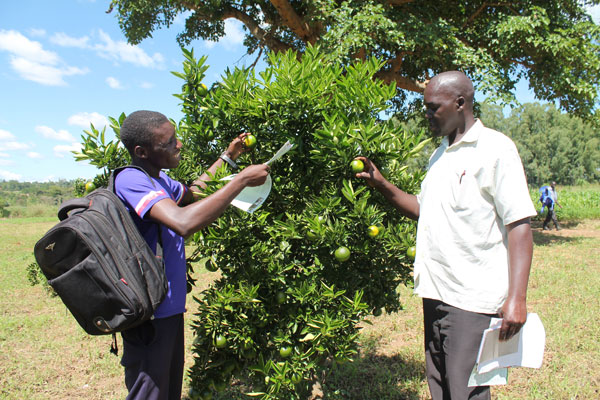Oranges are the game changer

Farmers check out oranges in Uganda in 2019. PHOTO/KELVIN ATUHAIRE
What you need to know:
Just when you thought you had grasped it all in citrus production, NgettaZardi crop experts Apele Bushira and Alfred Kumakech step in to unveil the latest orange fruit varieties that if managed well, can yield the best produce. Denis Bbosa was in Lira for insights about the five must-grow citrus varieties that will ultimately reshape the production landscape in the country.
A year ago at the Ngetta Zonal Agricultural Research and Development Institute (NgettaZardi), citrus production best practices illuminated the maiden Seeds of Gold Farm Clinic in the region.
Last Saturday, the many attendants could not resist the allure of learning the five money minting varieties on the market – American tangerine, Lomanti, Valencia, Washington Nova and Frost Washington that Apele Bushira and Alfred Kumakech expertly elaborated in a practical approach.
Varieties
According to the experts, the American tangerine is an improved version from the local varieties. They are juicy and sweet. It is a group of orange citrus fruits consisting hybrids of mandarin orange.
The Hamline varieties are perceived as sweet citrus fruits with smooth skin, not too heavy and when their fruiting season coincides with drought, the fruits become less juicy but sweeter.
For the Frost Washington, Bushira and Kumakech stress that the varieties are seedless and in terms of juice manufacturing they are an endowed species.
The Washington Nova varieties according to experts, are the best for any active and prospective citrus farmer in Uganda especially those intending to supply to factories. They have all the characteristics of local tangerine varieties.
Valencia oranges are recommended as a good source of potassium, an electrolyte mineral that helps maintain proper fluid levels and may also promote optimal heart function.
Benefits
The crop experts say oranges have high-fibre diets that help reduce the risk of certain cancers, especially, colon cancer.
In other health benefits, the experts add that Vitamin C in oranges is vital in treatment of scabies and since they are low in cholesterol, the lemons help in controlling fats in the body. Most upcountry farmers also venture in citrus production to stimulate their incomes and improve their livelihoods.
Seed selection
This is the first step in citrus production. You are supposed to get seedlings from research centres or certified nursery beds because they have knowledge of management of diseases and budding.
Bush clearing
Clear natural vegetation and hills, two methods for this; chemical (use of weed masters, herbicides) and manual method (mechanical use of farm tools like pangs tractors).
Avoid bush burning, because you can burn people’s crops, forest activists say you will kill species, soil scientists say you kill living organisms, soil PH and nutrients such as oxygen.
Planting
You need to know the spacing that is to say, an acre is 4000m2, hectare 2.5 acres in one (10000m2). Spacing is six meters by six, from one plant to another is also six metres.
Digging hole
The depth of the hole should be two feet. You are advised to dig the holes 30 days before planting. It is highly recommended you add organic fertilisers in the holes.
Disease and pests
Agronomist say fruit fly is the major pest that attacks the fruits especially oranges. These insects lead to loss of 80 per cent of the orchard.
It is highly recommended that the affected fruits be removed and buried immediately.
Site selection
One factor to be considered is the slope or topography. Gentle slope neither too steep nor too flat because when it rains the run off will allow aeration. Citrus fruits do not do well in water logged areas like other crops.
Avoid rocky places because they disturb root development, avoid stony or murram areas because in case of a storm, it will not stay and avoid swampy areas.
Citrus fruits do not do well in places with shade such as tree shades and the soil should be sandy, loamy and deep.


